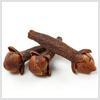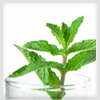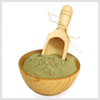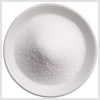Home Remedies for Gingivitis
The gingiva is the part of the oral mucous membrane attached to the teeth and alveolar processes of the jaws. Histologically the gingiva is composed of keratinizing epithelium and connective tissue. Clinically and histologically, gingivitis refers to inflammation limited to the free gingiva. It does not specifically include any inflammatory process that may extend to the underlying bone or periodontal ligament. Marginal gingivitis often results from poor oral hygiene. Predominant organisms in the early stages of gingivitis include gram positive rods such as actinomyces. However spirochetes may also be involved. Treatment simply involves improvement of oral hygiene, but systemic antibiotics may be required for treatment of acute episodes. Some clinical and home remedies for gingivitis are given below:
Natural Remedies for Gingivitis
Clove Oil as a Home Remedy for Gingivitis
 Properties: Clove oil is 60 to 90 percent eugenol, which is the source of its anesthetic and antiseptic properties. Dentists use clove oil as an oral anesthetic and to disinfect root canals. It is an ingredient in the toothache remedies dentapine and orajel; in Numzit, an anesthetic for teething pain; and in the lip balms blistex and orabase. In addition, several products for oral discomfort contain eugenol including Dent-Zel-Lte toothache relief, dentempm temporary filling mix and Red Cross toothache medication. Keep in mind though that toothaches require professional care. Clove oil and products that contain either clove oil or eugenol may provide temporary relief, but you need to see a dentist promptly. Clove has other medical uses. For instance, clove helps relax the smooth muscle lining the digestive tract, supporting the herb´s age old use as a digestive aid. Clove also kills intestinal parasites and exhibits broad antimicrobial properties against fungi and bacteria.
Properties: Clove oil is 60 to 90 percent eugenol, which is the source of its anesthetic and antiseptic properties. Dentists use clove oil as an oral anesthetic and to disinfect root canals. It is an ingredient in the toothache remedies dentapine and orajel; in Numzit, an anesthetic for teething pain; and in the lip balms blistex and orabase. In addition, several products for oral discomfort contain eugenol including Dent-Zel-Lte toothache relief, dentempm temporary filling mix and Red Cross toothache medication. Keep in mind though that toothaches require professional care. Clove oil and products that contain either clove oil or eugenol may provide temporary relief, but you need to see a dentist promptly. Clove has other medical uses. For instance, clove helps relax the smooth muscle lining the digestive tract, supporting the herb´s age old use as a digestive aid. Clove also kills intestinal parasites and exhibits broad antimicrobial properties against fungi and bacteria.How to treat gingivitis using clove oil:
For temporary relief of toothache prior to professional care, dip a cotton swab in clove oil and apply it to the affected tooth and surrounding gum. When using commercial clove oil or eugenol preparations, follow the package directions. To make a good infusion (pleasant and tasting), use one spoon of smashed herb per cup of boiling water and steep for ten to twenty minutes, then strain if you wish. Take up to three cups a day.Mint as a Home Remedy for Gingivitis
 Properties: All edible mints are anti-inflammatory, antiseptic, antibacterial, antispasmodic, anti-flatulent and effective stimulants. A tea made of a thumb length spring in one cup of boiling water eases digestion and provides relief from abdominal discomfort and stomach upsets. During exam time a cup of peppermint tea works wonders to help concentration and ease nervous energy. For menopause peppermint flower tea will relieve hot flushes, will help ease digestive problems, take away a bloated feeling, and will help heartburn and a rapidly beating heart. Peppermint tea will also relieve cold and flu symptoms..
Properties: All edible mints are anti-inflammatory, antiseptic, antibacterial, antispasmodic, anti-flatulent and effective stimulants. A tea made of a thumb length spring in one cup of boiling water eases digestion and provides relief from abdominal discomfort and stomach upsets. During exam time a cup of peppermint tea works wonders to help concentration and ease nervous energy. For menopause peppermint flower tea will relieve hot flushes, will help ease digestive problems, take away a bloated feeling, and will help heartburn and a rapidly beating heart. Peppermint tea will also relieve cold and flu symptoms..How to treat gingivitis using mint:
Chew a sprig of any mint and the flower to sweeten the breath and use the mint tea as a gargle and mouth wash to clear mouth and gum infections.Babul as a Home Remedy for Gingivitis
 Properties: Babul is planted for its bark. The tree yields a gum known as babul gum. The bark of babul tree contains tannin and gallic acid. The leaves and fruits of the tree also contain tannin and gallic acid. The pods, the leaves, and the bark of the babul have medicinal properties. The bark and leaves are beneficial in preventing bleeding or secretion.
Properties: Babul is planted for its bark. The tree yields a gum known as babul gum. The bark of babul tree contains tannin and gallic acid. The leaves and fruits of the tree also contain tannin and gallic acid. The pods, the leaves, and the bark of the babul have medicinal properties. The bark and leaves are beneficial in preventing bleeding or secretion. How to use babul for treating gingivitis:
Use the bark or pods or gum of the tree and make a paste and apply on the painful area.Neem as a Home Remedy for Gingivitis
 Properties: According to ayurvedic resources, neem is a powerful blood purifier and detoxifier. Neem reduces fever and toxins involved in most inflammatory skin diseases and is effective in the treatment of malaria. Its harsh work promotes curing and it is employed to treat rheumatism, arthritis, nausea, thirst, parasites, and skin diseases and much more. Neem stimulates the production of T-cells to fight infections. It boosts the immune system on all levels while helping the body fight infection. Modern usages include those for various cancers and for AIDS. People both in India and Africa have used neem twigs as tooth brushes for centuries. Twigs of neem have special antiseptic ingredients vital for oral hygiene. Powdered neem is also employed to massage gums and brush teeth. Sore gums, bleeding, tooth decay and tooth infections have all been cured with day to day use of neem leaf or mouth rinse extract mixed with water. Some people have reported a total reversal of gum degeneration after using neem for only a few months.
Properties: According to ayurvedic resources, neem is a powerful blood purifier and detoxifier. Neem reduces fever and toxins involved in most inflammatory skin diseases and is effective in the treatment of malaria. Its harsh work promotes curing and it is employed to treat rheumatism, arthritis, nausea, thirst, parasites, and skin diseases and much more. Neem stimulates the production of T-cells to fight infections. It boosts the immune system on all levels while helping the body fight infection. Modern usages include those for various cancers and for AIDS. People both in India and Africa have used neem twigs as tooth brushes for centuries. Twigs of neem have special antiseptic ingredients vital for oral hygiene. Powdered neem is also employed to massage gums and brush teeth. Sore gums, bleeding, tooth decay and tooth infections have all been cured with day to day use of neem leaf or mouth rinse extract mixed with water. Some people have reported a total reversal of gum degeneration after using neem for only a few months.
How to use neem to treat gingivitis:
Use neem powder to wash your teeth. This will help you to reduce the gingivitis.Hydrogen Peroxide as a Home Remedy for Gingivitis
 Properties: Much controversy has surrounded the use of food grade hydrogen peroxide for therapeutic, anti-infective and antifungal health care. The experience with this source of nascent oxygen has been successful in many areas, but a great deal of that success is predicated on the way water is used. Proper medical directions are very specific as to dosage and ailment. Read the bottle label carefully before embarking on a program that includes hydrogen peroxide. Food grade hydrogen peroxide is attainable in two refrigerated types. When using it externally hydrogen dioxide is suggested while when using it internally magnesium dioxide is suggested. Gingivitis inhibiting mouthwashes may contain essential oils or phenol or oxygenating agents like peroxy carbonate, buffered sodium peroxyborate and hydrogen peroxide, bisguanide antiseptics or chlorhexidine. Chlorhexidine has antiplaque properties. Anti-microbial or antiplaque mouthwash is employed to avert plaque bacterial build up and resolve or prevent severe gingivitis.
Properties: Much controversy has surrounded the use of food grade hydrogen peroxide for therapeutic, anti-infective and antifungal health care. The experience with this source of nascent oxygen has been successful in many areas, but a great deal of that success is predicated on the way water is used. Proper medical directions are very specific as to dosage and ailment. Read the bottle label carefully before embarking on a program that includes hydrogen peroxide. Food grade hydrogen peroxide is attainable in two refrigerated types. When using it externally hydrogen dioxide is suggested while when using it internally magnesium dioxide is suggested. Gingivitis inhibiting mouthwashes may contain essential oils or phenol or oxygenating agents like peroxy carbonate, buffered sodium peroxyborate and hydrogen peroxide, bisguanide antiseptics or chlorhexidine. Chlorhexidine has antiplaque properties. Anti-microbial or antiplaque mouthwash is employed to avert plaque bacterial build up and resolve or prevent severe gingivitis. Treatment for gingivitis using hydrogen peroxide:
You can add some drops of hydrogen peroxide in water and use this water for gargling.Calcium as a Home Remedy for Gingivitis
 Properties: Calcium is vital for the proper development and maintenance of calcified oral tissues. These include tissues incorporated into the structure of the teeth themselves and the bone in which they are embedded. The mineralized tissues of the tooth, enamel, cement and dentin, have characteristics that are distinct from bone. Many people have found calcium effective in stopping tooth problems and healing broken bones.
Properties: Calcium is vital for the proper development and maintenance of calcified oral tissues. These include tissues incorporated into the structure of the teeth themselves and the bone in which they are embedded. The mineralized tissues of the tooth, enamel, cement and dentin, have characteristics that are distinct from bone. Many people have found calcium effective in stopping tooth problems and healing broken bones.Treatment for gingivitis using calcium:
Calcium is vital for having healthy teeth. Hence ensure that your food provides you a maximum amount of calcium.Baking Soda as a Home Remedy for Gingivitis
 Properties: Baking soda is famous for removing plaque.
Properties: Baking soda is famous for removing plaque.Treatment for gingivitis using baking soda:
Brushing the teeth with a solution of hydrogen peroxide, water and baking soda can remove plaque and clean the teeth.Other Home remedies for Gingivitis
Several natural methods can be used to prevent and treat gum disease. Brushing teeth at least two times a day and after meals and flossing properly between each tooth are extremely important.
Brushing the teeth at the gum line where plaque is located is essential.
Massaging the gum with the index finger after brushing and flossing will help loosen plaque.
Regular visits to a dental hygienist or dentist should be made every four to six months. Certain vitamins and supplements are known to help gum disease.
Hepar sulph is beneficial when the mouth and gums are very painful to touch and the gums bleed easily. The gums are infected and often ooze bloody pus. Cold air bothers the gums and teeth.
Lanchesis is helpful when the gums are spongy, swollen and bleed easily. A toothache radiates to the ears. There may be a sensation of constriction around the neck. People who need this remedy often wake up from a nap or sleep and have more pain than before. Silica is useful for sore, swollen gums that have a tendency to form abscesses and boils. Silica helps ripen the abscesses.
Staphysagria is often useful for people who have smoked too many cigarettes and have other excessive habits. The gums become spongy and bleed easily. The teeth actually turn black and begin to crumble.
Diet for Gingivitis
A diet high in refined carbohydrates (especially sucrose) promotes periodontal disease.
Frequent consumption of sugar increases plaque buildup and risk of gingivitis. Sugars also promote periodontal disease by reducing the ability of the white blood cells in the gums to kill the dangerous bacteria of plaque.
Sucrose in sticky form is really destructive (like baked goods or candy) because it clings longer to the teeth.
Regular intake of foods rich in vitamin C, high quality protein and zinc can help maintain the integrity of the periodontal tissues.
The vitamin C is essential for the maturation of collagen and acute deficiency results in oedema and hemorrhage of the periodontal ligament and tooth mobility, as the alveolar bone is also affected. Vitamin C is also required for wound healing.
The only other micronutrient reported to have any beneficial effect in the gingival tissues is foliate. Both systemic and topical administration trials have been undertaken using folic acid mouth rinse.
The only macronutrient worthy of discussion in this section on nutrition and periodontal disease is carbohydrate. It is well documented that increasing the sucrose content of the diet will increase the bulk of supragingival plaque.
| Add your Home Remedy below.. | |

